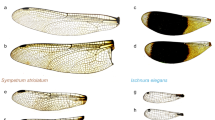Summary
-
1)
Bees hanging on an aerodynamic two component balance were placed in front of a laminar wind tunnel. They controlled the wind velocity in the tunnel through a servo-mechanism that held the wind velocity to exactly the opposite of the flight speed, thus selecting lift and thrust freely. The parameters lift, wind velocity, occurrence of action potentials in the indirect dorsoventral flight muscles (DV) and indirect dorsolongitudinal flight muscles (DL) and body temperature were measured. The correlations were analysed (Fig. 1).
-
2)
The lift is positively correlated to the body angle (angle between body length axis and wind tunnel length axis), the flight speed is negatively correlated to the body angle (Fig. 2).
-
3)
Action potential frequencies in both muscle groups exhibit a strong positive correlation to the lift (Fig. 3). Changes in action potential frequencies and lift run parallel with a delay of less than 200 msec (limitation imposed by measuring system). Different motor units in a given muscle have different absolute discharge frequencies (Fig. 4).
-
4)
A pronounced synchronization between wingbeats and action potentials in the indirect dorsoventral muscles can always be found.
-
5)
Randomly triggered photographic pictures show the wings most frequently at the lower turning point. Exposures that were triggered by action potentials in the dorsoventral indirect flight muscles display this wing position significantly more frequently (Fig. 5).
Zusammenfassung
-
1)
Bienen wurden vor einem laminaren Windkanal an einer aerodyamischen Zweikomponentenwaage aufgehängt. Sie konnten Auftrieb und — über eine Servosteuerung der Kanalgeschwindigkeit (die entgegengesetzt gleich der Fluggeschwindigkeit ist) — Vortrieb frei wählen. Die Parameter Auftrieb, Windgeschwindigkeit, Auftreten von Aktionspotentialen in den indirekten dorsoventralen (DV) und dorsolongitudinalen (DL) Flugmuskeln und Körpertemperatur wurden gemessen und mit einem Philips Analog 7, 4-Spur-Bandgerät registriert;ihre Korrelationen wurden mit einem Nova 1200 Digitalcomputer und einem Nuclear Chicago Data Retrieval Computer (Model 7100) analysiert (Abb. 1).
-
2)
Der Auftrieb ist positiv, die Fluggeschwindigkeit negativ zum Rumpfanstellwinkel (Winkel zwischen Tierlängsachse und Kanallängsachse) korreliert (Abb. 2).
-
3)
Aktionspotentialfrequenzen in beiden Muskelgruppen zeigen starke positive Korrelationen zum Auftrieb (Abb. 3). Änderungen der Aktionspotentialfrequenzen und des Auftriebs laufen parallel mit einer Verzögerung von weniger als 200 msec (Grenze der Meßgenauigkeit) (Abb. 4). Verschiedene motorische Einheiten in einem gegebenen Muskel zeigen unterschiedliche absolute Entladungsfrequenzen.
-
4)
Man findet stets eine ausgeprägte Synchronisation zwischen Flügelschlägen und Aktionspotentialen in den Dorsoventralmuskeln.
-
5)
Zufällig ausgelöste Fotoaufnahmen zeigen die Flügel am häufigsten am unteren Wendepunkt des Flügelschlages. Bilder deren Auslösung von Aktionspotentialen in den Dorsoventralmuskeln getriggert worden war, zeigen diese Stellung signifikant häufiger (Abb. 5).
Similar content being viewed by others
References
Bastian, J.: Neuro-muscular mechanisms controlling a flight maneuver in the honeybee. J. comp. Physiol.77, 126–140 (1972)
Bastian, J., Esch, H.: The nervous control of the indirect flight muscles of the honeybee. Z. vergl. Physiol.67, 307–324 (1970)
Heide, G.: The influence of wingbeat synchronous feedback on the motor output systems in flies. Z. Naturforsch.29, 739–744 (1974)
Nachtigall, W., Wilson, D.M.: Neuro-muscular control of dipteran flight. J. exp. Biol.47, 77–97 (1967)
Nachtigall, W., Widmann, R., Renner, M.: Über den „ortsfesten“ freien Flug von Bienen in einem Saugkanal. Apidologie2, 271–282 (1971)
Neuhaus, W., Wohlgemuth, R.: Über das Fächeln der Bienen und dessen Verhältnis zum Fliegen. Z. vergl. Physiol.43, 615–641 (1960)
Pringle, J.W.S.: The excitation and contraction of the flight muscles of insects. J. Insect Physiol.108, 226–232 (1949)
Pringle, J.W.S.: Insect flight. 132 pp. Cambridge: University Press 1957
Pringle, J.W.S.: Locomotion: Flight. In: The physiology of insecta (M. Rockstein, ed.), vol. II, p. 283–329. New York and London: Academic Press 1965
Roeder, K.D.: Movements of the thorax and potential changes in the thoracic muscles of insects during flight. Biol. Bull. (Woods Hole)100, 95–106 (1951)
Vogel, S.: Flight in Drosophila. I. Flight performance of tethered flies. J. exp. Biol.44, 567–578 (1966)
Wendler, G.: The influence of proprioreceptive feedback on locust flight co-ordination. J. comp. Physiol.88, 173–200 (1974)
Wilson, D.M.: The nervous coordination of insect locomotion. In: The physiology of the insect central nervous system (J.E. Treherne, J.W.L. Beament, eds.), p. 125–140. London and New York: Academic Press 1965
Wilson, D.M.: The nervous control of insect flight and related behavior. Adv. Insect Physiol.5, 289–339 (1968)
Wyman, R.J.: Multistable firing patterns among several neurons. J. Neurophysiol.29, 807–833 (1966)
Author information
Authors and Affiliations
Additional information
Supported by NSF grant GB 13494 to Harald Esch and a Deutsche Forschungsgemeinschaft grant to Werner Nachtigall. We thank all members of the group “Flugbiophysik” in Saarbrücken, especially Dr. W. Zarnack, for continuous technical help, master mechanic Mr. R. Jacobi for the construction of the flight balance and the wind tunnel controls and Ms. Pamela D. McCormick for the filming of the wing positions.
Rights and permissions
About this article
Cite this article
Esch, H., Nachtigall, W. & Kogge, S.N. Correlations between aerodynamic output, electrical activity in the indirect flight muscles and wing positions of bees flying in a servomechanically controlled wind tunnel. J. Comp. Physiol. 100, 147–159 (1975). https://doi.org/10.1007/BF00613966
Received:
Issue Date:
DOI: https://doi.org/10.1007/BF00613966




